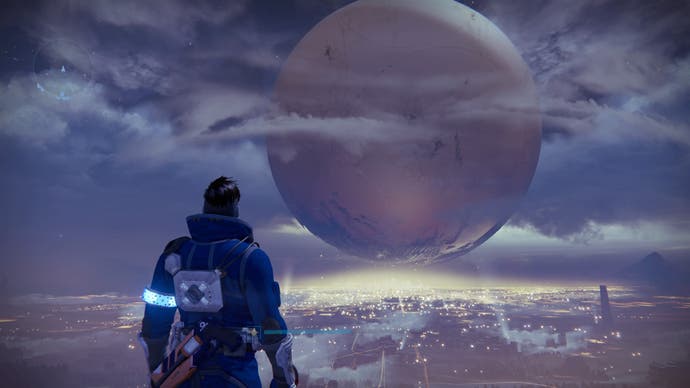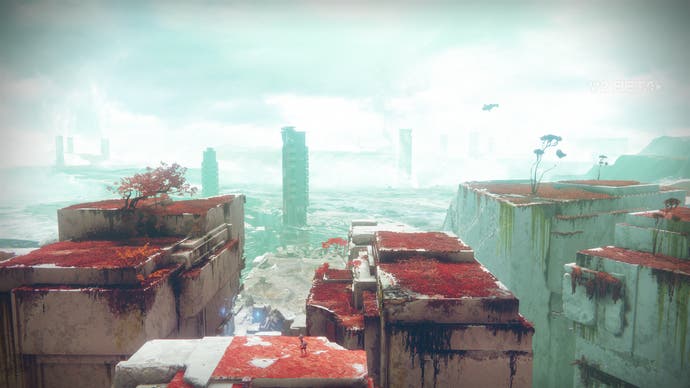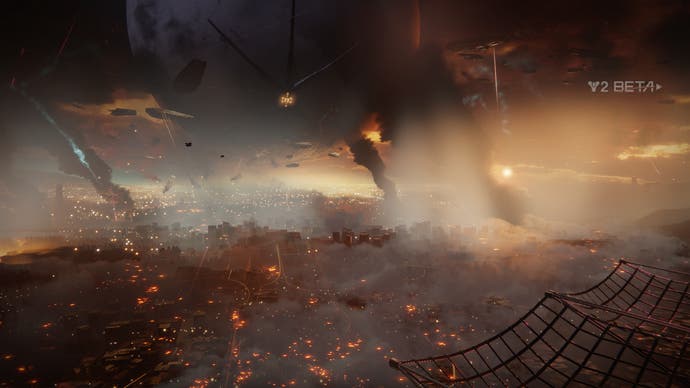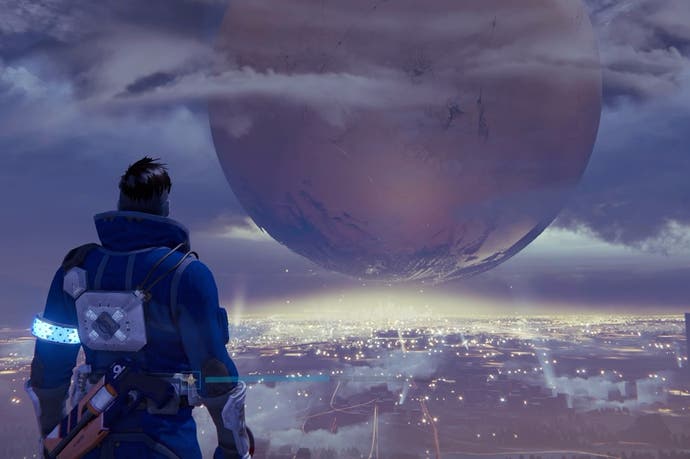Tracing the panoramic obsessions of Destiny
Kings of the vast.
Editor's note: Once a month we invite the wonderful Gareth Damian Martin, editor of Heterotopias, to show us what proper writing about games looks like before we shoo him away for making the rest of us look bad. You can read Gareth's pieces on Dark Souls and Resident Evil - and you really should! - before settling into this month's piece about Bungie's delicious skyboxes.
When the Destiny 2 Beta opened up the game's new hub, The Farm, for a single hour last weekend, I'll admit I was intrigued. Beyond the crimson jungles of Nessus and the pair of multiplayer maps the slim test made available, The Farm is the space that will become the new home for players of the series. It will, as far as we can tell, be the point from which all journeys begin, and the structure in which they will end, with rewards, congratulations and customary dancing.
Yet, loading into that space stripped clean of any hints of its inhabitants, scoured of spoilers and plot details, the experience felt less like moving into a new home and more like walking on set before the show begins, taking in the forms and shapes of the architecture, and the way the space colors the air, but little more. A bloodless heart, waiting to begin beating.
The Tower, the Farm's lofty predecessor, was always the architectural heart of Destiny. Since the launch of the game three years ago, Bungie went out of its way to drag players back to that oversized balcony, to collect rewards, find friends, or just idle beneath a painted sky. That a loot market under a skybox might be the centre point of Destiny is telling of both Bungie's intentions with the original game, but also of the developer's history. Bungie's entries in the Halo series were a lesson in visual escalation, each one setting its distinctive combat bowls against an increasingly grandiose set of skies, eager to drag your eyes from the action towards the world beyond. I have always associated Bungie's artists' love and mastery of cloud forms with their composers' equal mastery of choral arrangements-both being ethereal, formless things that gesture at unspoken greatness with little specificity. Halo: Reach, what would be the studio's final contribution to the series, let that mist-laden grandeur bleed into its main menu, depicting a landscape receding into fog, beneath a chorus of clouds that seem to wrap themselves in an ever-perfect composition around the distant shape of a ringed crescent planet.

That planet might be thought of as a precursor to Destiny's Traveler, the vast white orb that hung first like a symbol of untold promise, and then over time, like a lead balloon of missed opportunities, over the Tower for the course of the game's' three years. I suppose it is tempting to think of the Traveler, not the Tower, as the architectural symbol at the centre of the game: a golden-age sci-fi tinged symbol of bright futures and campy space magic, pulled wholesale from a John Harris or Chris Foss paperback cover.
But in the world of Destiny, the Traveler, like the city it rests on, or the landscape that frames it, does not exist. As players, we never set foot in it, approach it, or get closer to it than standing on one side of the Tower's elegantly sculpted handrail. It is a prop, a backdrop, a stand-in. It is not so much a piece of architecture as it is an image, the realisation of Bungie's artists decade-long task of painting beautiful, distant spheres in the service of the idea of an almost graspable but ever-receding future. From an architectural perspective, when we stand on the Tower and gaze out at the Last City and its shifting weather beneath the Traveler we are not looking at a landscape, but a model, a miniaturised world set against a flat dome of sky, a panoramic painting made from brushstrokes of clouds and light.
I use that word knowing it has a history, one with as many painted clouds and perfect skies as any Bungie game. The precursor to the spectacle of disaster movies and the ever widening aspect ratios of cinema, panoramic paintings were one of the grand entertainments of the early 19th century. It was painter Robert Barker who coined the term, and created the first purpose-built circular gallery to house his work-a vast immersive painting of the Edinburgh skyline. That building encased its visitors in a strip of painted sky, placing them on a raised platform from which they could view its seemingly distant expanse from behind a hand rail. In a similar way to how the cover's of science fiction paperbacks can be traced through Reach's painted planet to the Traveller, this rotunda represents the protean image of Destiny's tower. More than 200 years might seem like an unnecessary amount of time to trace the heritage of a digital space over, but I do so for a reason. Decades of thinking about games as worlds, as whole fictional universes opened up to our every whim, has blinded us.

When we look out from the Tower we think we see a city and a huge orb, when we are no more looking at a city as when the well-to-do of London marveled at Barker's Edinburgh stretched out before their eyes in 1801. I'm not saying that the Last City is fictional, that much is obvious, but that even in the world of Destiny it doesn't exist, and that if we wish to understand Destiny's tower, and even the rest of the game's locations, as an architectural space, we shouldn't do it through the history of cities or landscapes or buildings or landscapes, but through this odd legacy of the first, albeit brick-built, skybox which occupied a spot in Leicester Square.
Understanding that this architectural form - a platform around which a vast painted image has been stretched - is not just the Tower's true form, but the form of all Destiny's environments, allows us to see how it defines the aesthetic and architectural spaces of the game. Mars, the Moon, Venus, Mercury-we don't so much visit planets in Destiny as visit playgrounds, bordered by panoramas. This is of course true of many first-person, big budget games, but with Bungie and Destiny this is not just a technical device, a standard way of crafting fictional space, it is instead part of an ethos of distance, of grandeur, of the sublime. It is difficult to feel that Bungie wants its skies to remain as little more than competent backdrops, simply supporting the active world. Instead they seem to strain to upstage the landscape in front of them, glowing with neon nebulae, crisscrossed with jumpship trails, their golden-flaring sun nestling itself into a compositionally perfect spot in a wreath of clouds. And, if like the first panoramic paintings, they have grown out of a desire to do little more than immerse their audience in a place, they have now surpassed that function in their artistry, constantly reminding us of the impossible, constructed beauty of this extravagant world.
The 19th century too saw the panoramic painting go from impressive novelty to exceptional artistry, in the form of one painter in particular, John Martin. Though he never painted a rotunda panorama in as Barker famously did, his painting emerged at a time when the sublime had gone from a lofty artistic concept to a mode of entertainment, in the form of the huge number of touring panoramas that attracted significant audiences across the world. Martin capitalised on this interest, his massive paintings of biblical catastrophe literally dwarfing those he was hung alongside in the Royal Academy, earning him the backhanded compliment of being titled "King of the Vast". His first breakout work, Joshua Commanding the Sun to Stand Still upon Gibeon, though treated with disdain by the academy, was unexpectedly popular with the visiting public, and presaged the improbable success of his masterpiece Belshazzar's Feast which in 1821 attracted an unprecedented 5000 visitors to the academy. His work would go on to be toured internationally, his prints sold in the thousands, and even copycat panoramas of his paintings set up across the world.

Even looking at those paintings now, you can still feel their power, contained not in their feeble figures dwarfed by vast forces, but in those skies, swirling with layers of cloud and launching assaults of lightning bolts on the monolithic architectures of man. Martin may have drawn in the same popular audiences as the popular but technical, lifeless panoramas, but he did so with an energy, scale and fervour all of his own. It is those qualities that Destiny's own panoramas share with his work. Just look at his depiction of the destruction of Pompeii, its apocalyptic majesty bears a distinct similarity to the volcanic storms of Destiny's Venus. It is not that there is a direct line of influence to be traced, but that these grand skies, ostentatious in their purposeful composition and painterly style, fit a tradition of backdrops that aspire not towards reality or even nature, but the absolute artistry of the fantastic.
So where does that leave the humbly named Farm? Or the plateaus of Nessus? Or any of our first glimpses of Bungie's new spaces for Destiny 2? Well, though my hour in the Farm was mostly spent gazing out onto a shard of the Traveller, belching Martin-esque smoke into a gathering storm of biblical proportions, I couldn't help but detect something of a shift. Perhaps it is because, unlike the Tower, its edges prescribed by that neat little handrail, the Farm is part of this landscape. And I know that that shard of the Traveler, cracked open as if to inspire the desire to see what lies inside, is a breadcrumb on a trail, a place that I might set foot in, not just a hollow symbol.

Not that the unreachable distance is gone, as my time on Nessus proved. Picking my way among the vast white canyons fringed with blood-red undergrowth, apparently inspired by Tepui, the strange tabletop mountains of South America, it was hard not to be distracted by the bizarre sight of a turquoise sky. This is perhaps the most ostentatious Destiny has ever been, especially when strange monolithic machinery is set against this shock of colour, emerging from the now ubiquitous field of cloud. Could anything feel more painted, more constructed, more imbued with an eagerness for a sense of vast unreachable fantasy than this insane neon sky? Knowing that the remaining Destiny locations, Io and Titan are both moons, it's hard not to image that they too won't make the most of Jupiter and Saturn, hanging in their skies as vast props for the imaginations of its players to run across.
Even Homecoming, the single campaign mission included in the Beta seemed to point towards the escalation, not rejection of Bungie's skybox obsession. Here the drama of the Last City's destruction and the Traveler's imprisonment is played out in apocalyptic John Martin style across the towers once peaceful skybox, the finale of the mission lifting us up to a rotating ship so that, in a trick straight from the panorama artist playbook, we can better see the grandeur and sublimity of this living, burning, smoke-wreathed canvas. The spirit of the panoramic painter, if the Beta is anything to go by, is still alive and well in Destiny 2 then. But that shard, stabbed into the Farm's horizon, waiting to be delved into, still suggests that while there may be visions meant for a static panorama audience, set on a dome of virtual bricks, Destiny 2 may finally allow us to walk out beyond the rotunda walls, and step into a wonder or two as well.
If you're interested in checking out Heterotopias, there's a sale currently on for the first two issues.

